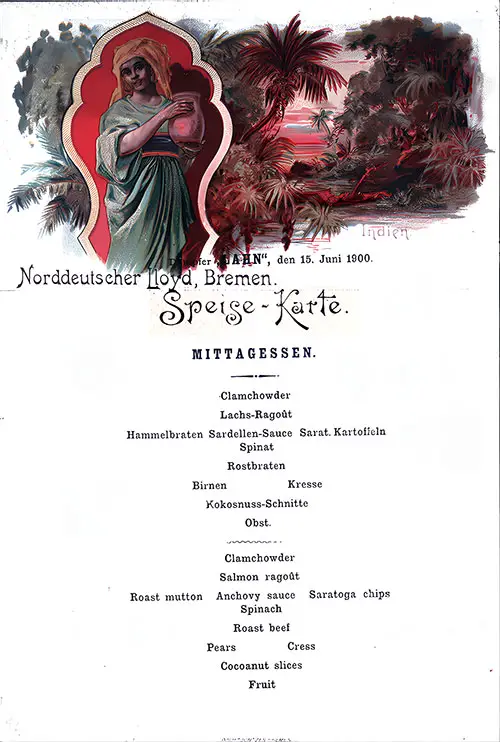SS Lahn Luncheon Menu Card - 15 June 1900

Front Side of a Vintage Luncheon Menu Card with an Illustration Labeled "Indien" -- a Scene featuring India with a Woman Carying a Vase. It Is for an Unstated Class of Passengers for a Friday, 15 June 1900 Eastbound Voyage of the SS Lahn of the North German Lloyd. Featured Items included Salmon, Roast Mutton, and Assorted Fruit. The Menu Is Written in German and English. (Norddeutscher Lloyd) | GGA Image ID # 1a268364c5
🛳️ Luncheon at Sea: A Culinary Review of the SS Lahn Menu – 15 June 1900
🍽️ “Dining Aboard a North German Lloyd Steamer in the Belle Époque”
🍴 Menu Overview & Historical Dining Context
This Luncheon Menu from the SS Lahn of the North German Lloyd, dated 15 June 1900, provides a succinct yet flavorful snapshot of transatlantic dining during the Edwardian era. Although the passenger class is unstated, the menu’s bilingual format (German & English), restrained yet refined dish selection, and presence of specialty sauces and fresh fruit suggest it likely belonged to the Second Cabin—a class designed for the middle-class traveler seeking quality without the extravagance of First Class.
Menu Items
- Clam Chowder
- Salmon, Ragoût
- Roast Mutton
- Anchovy Sauce
- Saratoga Chips
- Spinach
- Roast Beef
- Pears
- Cress (Garden Cress)
- Cocoanut Slices (Coconut Slices)
- Fruit (Assorted Fruit)
Menu Items in German
- Clamchowder
- Lachs-Ragoût
- Hammelbraten
- Sardellen-Sauce
- Sarat. Kartoffeln
- Spinat
- Rostbraten
- Birnen
- Kresse
- Kokosnuss-Schnitte
- Obst
🧑🍳 Waiter's Review: What’s on the Table?
“Ladies and gentlemen, welcome to today’s midday service aboard the Lahn. May I guide you through our selections?” ☀️
🌟 Likely Featured Entrees
Roast Mutton with Anchovy Sauce
A hearty offering. The roast mutton—likely leg or shoulder—is slow-roasted for tenderness, accompanied by anchovy sauce, a savory and slightly pungent condiment made from mashed anchovies, butter, and perhaps cream. Anchovies were a favorite seasoning in European kitchens and not unusual at sea for their long shelf life. While delicious, this might have raised eyebrows among American diners unaccustomed to pairing fish-based sauces with lamb.
Salmon Ragout
This rich, stewed salmon dish features chunks of salmon gently simmered in a velvety white or tomato-based sauce. It’s an elegant and nourishing choice, especially on a Friday when Catholic passengers might observe a no-meat day. Its presence suggests attention to diverse dietary observances—particularly important on transatlantic liners carrying both tourists and immigrants.
🥄 Supporting Cast: Sides & Specialties
Clam Chowder
A nod to American palates. Likely a New England–style creamy chowder rather than the tomato-based Manhattan version. Clams were common on Atlantic menus due to their availability and association with coastal cuisine.
Saratoga Chips
Known today as potato chips, these were thinly sliced, fried potatoes that originated in Saratoga Springs, NY. In 1900, they were still considered a novelty and a treat. Delightfully crispy!
Spinach
A simple, well-prepared green. Likely buttered and lightly seasoned. A reliable complement to heavier meats and fish.
Roast Beef
For passengers seeking comfort food, this dish provides a more familiar Anglo-American fare. Simple, hearty, and hard to go wrong.
🍐 Desserts & Refreshments
Pears
Fresh or possibly poached—served chilled, a light and refreshing choice.
Cocoanut Slices
A sweet ending! These are likely sponge or shortbread bars topped with shredded coconut. At the time, coconut was a fashionable ingredient and considered a touch of the exotic.
Assorted Fruit ("Obst")
Seasonal selections such as apples, oranges, grapes, or plums would have been typical. Fruit was a sign of freshness and often used to demonstrate shipboard luxury.
❓ Unfamiliar or Unusual Items (For American Diners in 1900)
Anchovy Sauce 🐟
Though common in European kitchens, it might have surprised American diners when paired with roast meats.
Saratoga Chips 🥔
At the turn of the century, many Americans would still associate them with fine hotels or upscale dining, not casual snacking.
Cress (Garden Cress) 🌿
A peppery, leafy green used as a garnish or palate cleanser. Europeans appreciated it, but many Americans may have mistaken it for a weed or decoration.
🖼️ Engaging Imagery & Thematic Design
The illustrated menu card labeled “Indien” (India), with an exotic image of a woman bearing a vase, reflects the global fascination with the "Orient" during the colonial era. It’s a striking example of how ocean liners blended global imagery with Western luxury, and how brochures and menus doubled as souvenirs.
🧳 Educators, Genealogists, and Historians Take Note
For Teachers & Students: This menu is a primary source ideal for examining turn-of-the-century class divisions, food culture, and maritime logistics.
For Genealogists: Understanding daily meals helps humanize family stories. Did your ancestor travel Second Cabin on a steamship? They may have eaten this very meal.
For Historians: This snapshot shows how European ocean liners sought to balance continental flavors with Anglo-American expectations, especially as they competed with lines like Cunard and White Star.
🚢 Final Thoughts
This 1900 SS Lahn menu may appear modest at first glance, but it speaks volumes. From global spice routes hinted at in sauces, to vegetable choices aligned with seasonal Atlantic fare, it reveals how passengers experienced dignified travel at sea without First Class opulence. It reminds us that food at sea was not just sustenance—it was an experience, one carefully curated by steamship lines competing for loyalty.
🎩🍴✨ Bon appétit… in 1900 style!
